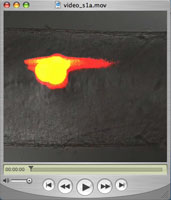 |

For further MBL News and Media Information, contact the MBL Communications Office at (508) 289-7423 or e-mail us at comm@mbl.edu
For Immediate Release
October 23, 2006
Contact: Gina Hebert
Tel: 508-289-7725; Cell: 508-717-1730
ghebert@mbl.edu
Researchers Find "ZIP Code" Spurs Cargo Transport in Neurons
Getting molecular cargo from the cell body to the synapse of nerve cells is crucial for learning and memory, even survival of the cell itself. New research conducted at Brown University and the Marine Biological Laboratory in Woods Hole, MA shows that a single peptide can load and direct this biological material. This peptide “ZIP Code” comes from amyloid precursor protein, the principal player in the development of Alzheimer’s disease.
PROVIDENCE, R.I. and WOODS HOLE, MA — For the first time, researchers have identified a peptide that can spur cargo transport in nerve cells, a discovery that could help scientists better understand nerve cell function and test possible therapies for neurodegenerative diseases. More>>>
Resources:
"A peptide zipcode sufficient for anterograde transport within amyloid precursor protein"*
Prasanna Satpute-Krishnan, Joseph A. DeGiorgis, Michael P. Conley, Marcus Jang, and Elaine L. Bearer
Download PDF of paper [here].
| Photos: Please click on thumbnails for high-resolution images |
|
Video: Please click for Quicktime video |
|
|
|
 |
|
 |
|
|
Loligo pealei, the Atlantic squid, has a giant axon that arises in the stellate ganglion behind the eye and runs the length of the mantle. By injecting designer nanobeads into the giant axon mimicking endogenous cargo, Bearer and her colleagues discovered a peptide within amyloid precursor protein (APP) that is sufficient to hitch cargo to fast axonal transport machinery for delivery to the synapse.
Photograph of squid in seawater tanks at the MBL, by Russell Jacobs and Elaine Bearer |
Bearer and her colleagues substituted beads coated with chemically synthesized peptides and injected them into the giant axon of the squid. Red beads are coated to APP-C. Green beads are coated to a different peptide also derived from APP, APP-N. This video shows the red beads moving rapdily down the axon towards the synapse whereas the green beads remain stationary at the injection site. |
|
|
|
 |
|
|
Elaine Bearer
Photo credit: T. Kleindinst |
|
|
Links:
|